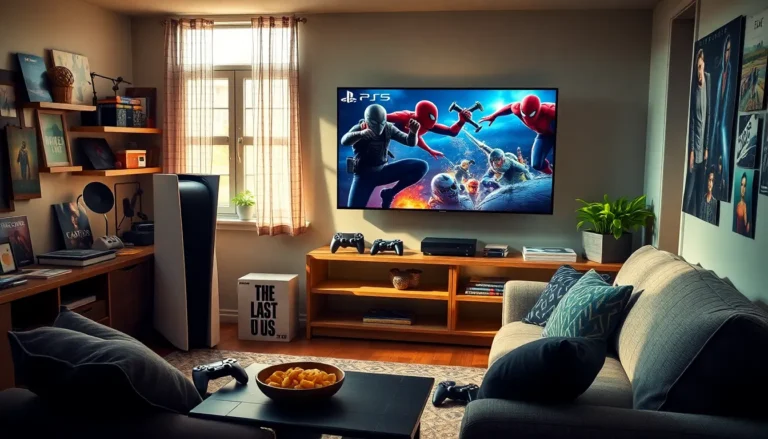Picture this: it’s the early 2000s, and gaming is about to get a serious upgrade. Enter the Game Boy Advance—a handheld console that had players whispering sweet nothings to their pixelated pals. Launched on March 21, 2001, in Japan, this little device packed a punch with its vibrant graphics and a library of games that could keep even the most dedicated couch potato entertained for hours.
It wasn’t just a console; it was a revolution in portable gaming. With its sleek design and impressive capabilities, the Game Boy Advance took gaming on the go to a whole new level. Whether you were battling foes in “The Legend of Zelda” or racing through “Mario Kart,” this gadget made it all possible—right in the palm of your hand. So, let’s dive into the history of this iconic device and explore its impact on the gaming world.
Table of Contents
ToggleOverview of Game Boy Advance
Game Boy Advance stands as a landmark in handheld gaming history. Launched on March 21, 2001, in Japan, this console introduced players to a more immersive gaming experience. Enhanced graphics showcased a 32-bit processor, allowing for detailed visuals and smooth animations.
Many gamers enjoyed an extensive library of titles, featuring iconic franchises such as Pokémon, Mario, and The Legend of Zelda. These games demonstrated the console’s capability for varied genres, attracting a wide audience.
The design captured attention with its sleek form factor and ergonomic features. Buttons positioned for comfort ensured prolonged play sessions, making it a favorite among enthusiasts.
Connectivity also marked a significant advancement. Game Boy Advance supported link cable functionality, enabling multiplayer experiences across devices. This innovation fostered social gaming, connecting players in both local and competitive settings.
Accessibility played a vital role in its success. The system used AAA batteries, providing up to 15 hours of gameplay, a crucial factor for on-the-go players.
Impact extends beyond hardware. It influenced future handheld consoles, setting standards for performance and design. Developers recognized the Game Boy Advance as a platform that cultivated creativity and diverse gameplay mechanics.
Release Date and Timeline
The Game Boy Advance marked a significant moment in portable gaming history with its release. This section outlines key milestones related to its announcement and launch.
Initial Announcement
Nintendo first unveiled the Game Boy Advance during its presentation at the Tokyo Game Show in November 2000. The excitement in the gaming community grew rapidly as details emerged about its capabilities. During the announcement, Nintendo showcased the device’s advanced features, including a 32-bit processor and improved graphics. The initial specifications hinted at a shift in portable gaming, appealing to both core and casual gamers. Anticipation built as developers expressed interest in creating games for the new platform.
Official Launch Date
The official launch of the Game Boy Advance occurred on March 21, 2001, in Japan. Gamers eagerly lined up to get their hands on this innovative console. Shortly after, the device reached North America and Europe in June 2001. This staggered release allowed Nintendo to capitalize on the growing interest in handheld gaming. By incorporating an extensive game library right at launch, the Game Boy Advance captured the attention of diverse audiences. Initial sales figures demonstrated its popularity, with over 81 million units sold worldwide, solidifying its status as a landmark in gaming history.
Technical Specifications
The Game Boy Advance features impressive specifications that enhance the gaming experience. Its advanced technology allowed for considerable improvements over its predecessors.
Display and Graphics
The Game Boy Advance showcased a 2.9-inch TFT color LCD with a resolution of 240 x 160 pixels. This screen displayed up to 32,768 colors simultaneously, providing vibrant visuals that captivated players. Developers capitalized on this display, creating detailed graphics that brought games to life. The powerful 32-bit ARM7TDMI processor enabled smooth animations and intricate designs, elevating portable gaming experiences significantly. Many titles utilized parallax scrolling and sprite scaling techniques, enhancing the immersive nature of gameplay.
Game Library
The Game Boy Advance boasted a rich library of over 1,500 titles, catering to diverse interests and preferences. Iconic franchises such as Pokémon, Mario, and The Legend of Zelda dominated the catalog, attracting both new and veteran gamers. Players experienced various genres, including action, adventure, and role-playing games. The platform supported backward compatibility, allowing access to original Game Boy and Game Boy Color titles, thus expanding its library further. Game developers embraced this console, resulting in a plethora of creative and engaging gameplay experiences that left a lasting impact on the industry.
Impact on Gaming Culture
The Game Boy Advance significantly shaped gaming culture since its release. Strong sales and rich game library made it a household name.
Reception and Popularity
Upon its launch, the Game Boy Advance received widespread acclaim. Critics praised its vibrant graphics and ease of use. Gamers appreciated its extensive library, including beloved titles like Pokémon and Mario. The device captivated a diverse audience, contributing to its sales of over 81 million units globally. Many noted its impressive battery life, enhancing its appeal for on-the-go play. By supporting multiplayer options, the console encouraged social interactions among players. This combination of features cemented the Game Boy Advance’s spot in gaming history.
Legacy and Influence
The Game Boy Advance set new benchmarks for portable gaming. Following its success, developers began creating more advanced handheld consoles. Many consider it the precursor to later devices like the Nintendo DS and the PlayStation Portable. Its backward compatibility with older Game Boy titles defined how future consoles approached game libraries. The influence of its design choices and user experience can still be seen today. Overall, it laid the groundwork for innovations in portable gaming, making a lasting impact on the industry.
Conclusion
The Game Boy Advance marked a pivotal moment in the evolution of handheld gaming. Its launch in 2001 not only introduced innovative technology but also captivated gamers with its impressive library and engaging gameplay. The console’s design and functionality set new standards for portable devices, making it a beloved choice for players of all ages.
With its vibrant graphics and extensive game selection, the Game Boy Advance left an indelible mark on gaming culture. Its influence can still be seen in today’s gaming landscape, as it paved the way for future handheld consoles. The legacy of the Game Boy Advance continues to resonate, reminding gamers of a transformative era in portable gaming history.





